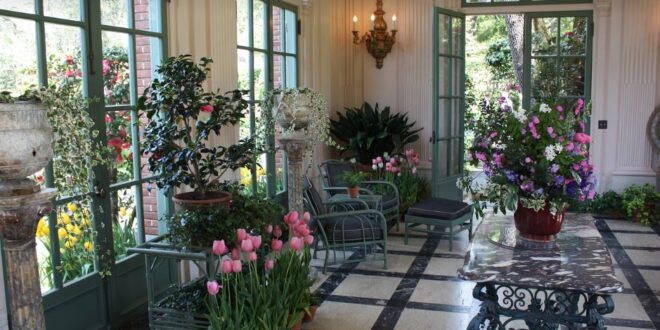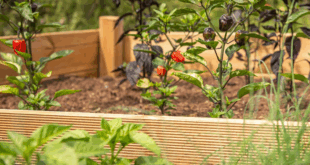The connection between indoor and outdoor spaces in a home is more than just a physical transition; it’s a harmonious blend of nature and architecture that can greatly enhance your living experience. A seamless flow between your indoor space and garden promotes a sense of well-being and brings the outdoors inside, creating a serene and inviting atmosphere. Several strategies exist to make this harmonious connection, whether you have a small patio or an extensive backyard. This article will explore essential tips for achieving a seamless flow between your indoor space and garden.
Design with a Unified Aesthetic
Creating a seamless flow between indoor and outdoor spaces begins with a unified aesthetic. Consider the architectural style, colour palette, and design elements in your home, and extend them to your garden. This could mean using similar materials, colours, and shapes for indoor and outdoor spaces. For example, if you have a modern and minimalistic interior, opt for clean lines and a streamlined design in your garden. A consistent aesthetic will help the two spaces feel like a natural extension of each other.
Use Large Windows and Glass Doors
Maximize the visual connection between your indoor space and garden by incorporating large windows and glass doors. These openings flood your interior with natural light and provide uninterrupted views of the outdoor landscape. Sliding glass doors, French doors, and floor-to-ceiling windows are excellent options. They create a sense of openness and make it easy to transition from inside to outside.
Establish a Focal Point
A focal point can draw the eye from indoors to the garden and vice versa. Consider placing a striking piece of outdoor art, a water feature, or a beautiful tree near a window or glass door. This will help anchor your view and encourage you to appreciate the beauty of both your indoor and outdoor spaces.
Create a Functional Outdoor Space
To encourage a seamless transition, your garden should be a functional extension of your indoor living area. Integrate comfortable seating, dining areas, and even an outdoor kitchen to make the garden a space to relax and entertain. This will ensure you use your garden as an additional living space, not just as a visual backdrop.
Use Complementary Flooring
Choosing complementary flooring materials for indoor and outdoor spaces can make the transition smoother. For example, you can use the same type of flooring indoors and outdoors or opt for materials with similar colours and textures. This creates a cohesive look and makes it feel like you’re stepping from one room to another when moving between the spaces.
Employ Indoor Plants
Bringing plants from your garden into your home is a fantastic way to blur the lines between indoor and outdoor spaces. Indoor plants not only improve air quality but also create a natural, inviting atmosphere. Consider placing potted plants strategically near windows, creating a lush indoor garden that complements the outdoor greenery.
Incorporate a Glass Wall or Atrium
A glass wall or atrium is an excellent choice for those who want to take the seamless flow concept to the next level. This architectural feature essentially merges your indoor and outdoor spaces, allowing you to enjoy your garden from the comfort of your home, regardless of the weather. It’s a striking design element that can create a sense of wonder and openness.
Install a Sliding Wall
Sliding walls or folding glass doors can be a game-changer in creating a seamless transition between your indoor and outdoor spaces. They allow you to open up an entire wall, effectively removing the barrier between the two areas. This is especially beneficial for those who love to entertain, as it enables a free flow of guests and makes your space feel larger.
Harmonize Colors and Materials
Coordinating the colour scheme and materials used in indoor and outdoor spaces is essential for a seamless flow. Use similar or complementary colours in your interior décor and outdoor furnishings. Consider using the same wood for your outdoor decking or furniture if your indoor space features wooden floors. This consistency creates a sense of harmony between the two areas.
Consider Zoning and Landscaping
To enhance the connection between indoor and outdoor spaces, use zoning and landscaping to define different areas within your garden. For instance, you can have a dedicated lounging area, a dining space, and a garden path that leads to these areas. This adds structure to your garden and encourages you to explore and engage with the outdoor space.
Lighting for Ambiance
Proper lighting is crucial for maintaining a seamless flow between indoor and outdoor spaces, especially after dark. Incorporate outdoor lighting that complements your interior lighting design. Pathway lighting, wall sconces, and pendant lights can help create a warm and inviting atmosphere that extends from your indoor space into the garden.
Use Reflective Surfaces
Integrating reflective surfaces, such as mirrors and glass tabletops, can help bounce natural light deeper into your indoor space while creating the illusion of a larger garden. Mirrors strategically placed in your garden can also give the impression of a boundless, lush landscape, enhancing the continuity between the two spaces.
Plan for All Seasons
To connect your indoor and outdoor spaces seamlessly, you’ll want to enjoy them year-round. Consider installing features like an outdoor fireplace, patio heaters, or retractable awnings to make your garden space comfortable in all seasons. This way, you can appreciate the seamless flow between your indoor and outdoor spaces, even amid winter.
Encourage Flow with Pathways
Use pathways, stepping stones, or decks to guide the movement between your indoor and outdoor spaces. This not only keeps your garden accessible but also enhances the feeling of transition and connection. Meandering pathways can create a sense of exploration and discovery, making the indoor and outdoor journey enjoyable. Installing limestone tiles on your indoor and outdoor floors can provide a luxurious and cohesive element, seamlessly connecting your living space to your garden.
Incorporate Water Features
Water features, such as ponds, fountains, or waterfalls, can introduce a soothing and dynamic element to your garden that complements the tranquillity of your indoor space. The sound of running water and the visual appeal of water features can be appreciated both inside and outside, blurring the boundaries between the two areas.
Maintain a Coherent Theme
A coherent theme in your garden design can greatly contribute to the seamless flow between your indoor and outdoor spaces. Whether it’s a Zen garden, a cottage garden, or a tropical paradise, maintaining a consistent theme helps create a unified atmosphere. Choose plants, furniture, and décor that align with your chosen theme.
Conclusion
A seamless flow between your indoor space and garden can transform your home into a tranquil and inviting oasis. By employing these tips, you can create a harmonious indoor and outdoor connection, making the most of your living space and fostering a sense of unity with nature. Whether you have a small urban balcony or a sprawling suburban backyard, these strategies can be tailored to suit your unique space, enabling you to enjoy the beauty of your garden from the comfort of your home.
 Gardeners Club The Gardeners Club is a free to join online club for everyone with an interest in gardening and gardens.
Gardeners Club The Gardeners Club is a free to join online club for everyone with an interest in gardening and gardens.






